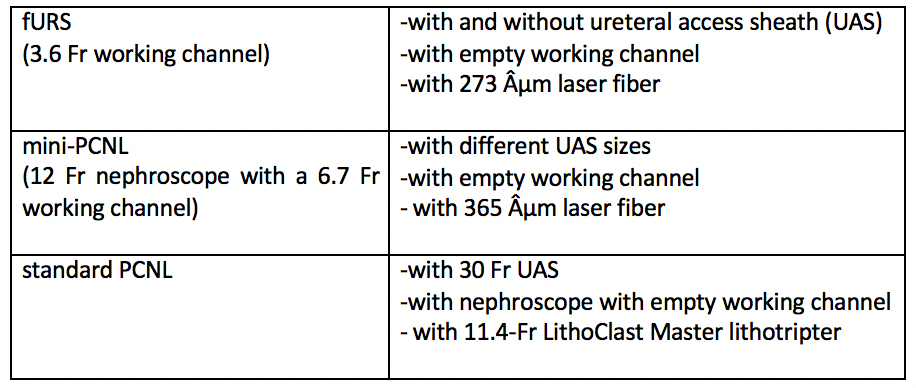Using a silicone model of the urinary tract (from kidneys proximally to urethra distally), the investigators measured IPP using a PressureWire placed in the renal pelvis and using the following combinations of instrumentation, each at 40 cmH2O and 193 cmH2O:

The investigators noted that IPP during fURS was always higher than that for mini- or standard PCNL. For fURS, they noted that the presence of a UAS or 273 Âμm laser fiber in the working channel both lead to decreased IPP at any irrigation pressure, and the lowest IPP pressure overall was seen when a UAS was combined with a laser fiber in the working channel at 40 cm H2O. While the use of a UAS during mini-PCNL resulted in a decreasing IPP with an increase in UAS size at all irrigation pressure settings.
The use of UAS as a core feature of these experiments sparked a lively discussion about the potential trade-off between the decreased IPP when using an access sheath (due to improved outflow) versus the increased ureteral wall pressure and potential for ureteral ischemia. Dr. Doizi suggested choosing a UAS that optimizes outflow but is not unnecessarily large so as to minimize ureteral damage. Another audience member noted that he was part of a study that found a 10/12 Fr UAS to be optimal in most cases with no significant change in ureteral blood flow when a UAS that is within 1.5Fr of a 10/12 Fr UAS was used.
The authors concluded that fURS result in higher IPP than mini-PCNL and standard PCNL, regardless of instrumentation and irrigant pressure.
Presented by: Steeve Doizi, MD, Urologist, Sorbonne University, Clinical Research Group, Hôpital Tenon, Paris, France, Paris, Ile-de-France, France
Co-Authors: Audrey Uzan, 1 Etienne Keller, 1 Vincent De Coninck,2 Maria Rodrigues-Monsalve Herrero,3 Olivier Traxer1
Author Affiliation:
1. Sorbonne University, Clinical Research Group
2. Algemeen Ziekenhuis Klina
3. University Hospital Puerta de Hierro, Majadahonda
Written by: Frank Jefferson, Department of Urology, University of California-Irvine, medical writer for UroToday.com at the 36th World Congress of Endourology (WCE) and SWL - September 20-23, 2018 Paris, France


